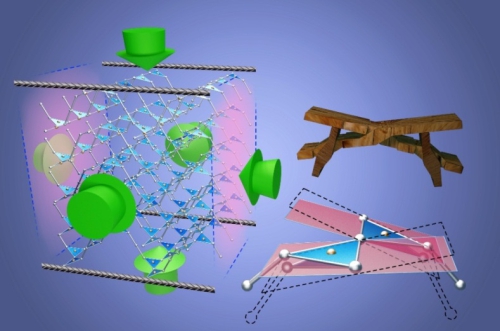When squeezed by hydrostatic pressure, majority of materials would contract along all the directions. However, there exists a type of exotic materials violating this widely accepted physical law: when being compressed along all the directions their size along a specific direction would keep constant, named as zero linear compressibility (ZLC) materials. Due to their high mechanical stability along the specific direction, these ZLC materials have significant implications for the performance-stability enhancement of the apparatus with high-precision operated in highly pressure-fluctuating environment.
So far, the studies on ZLC materials dominantly focus on the ultrahard materials with densified structures (e.g., diamond), and this rare pressure-responding behavior has been only discovered in very few members in this materials system. In comparison with densified-structure materials, non-dense materials has much advantage in population and structural types, and possess much superiority on the structure and performance manipulation owing to their open-framework structure.
Here, Prof. Zheshuai Lin’s group in Technical Institute of Physics and Chemistry, Chinese Academy of Sciences, established a theoretical model for the occurrence of ZLC behavior in non-dense materials, and proposed that the materials with the structure analogue to the “Lu-Ban Stool” in Chinese cultural heritage of woodworking could lead to the ZLC behavior. Through large-scale structural searching, they discovered the first ZLC materials with non-dense structure AEB2O4 (AE=Ca or Sr), by utilizing the Beijing synchrotron radiation facility. Under hydrostatic pressure, the linear compressibility of AEB2O4 along a-axis is lower than that of diamond, and their optical transmitting spectrum reach to deep-ultraviolet range with the cutoff of 170nm. Combining the ZLC behavior and excellent optical performance, they also performed the design for the ultra-precise optical sensor operated in the high-pressure fluctuating environment. This work has been published in Advanced Materials (Adv. Mater. 2018, 1801313), and highlighted by “Advanced Science News”.

"Lu-Ban Stool"-like Structure Stops Compression in non-dense borates under hydrostatic pressure
In recent years, Prof. Lin’s group focus on the anomalous mechanical / thermal performances in the borates with good optoelectronic functions. They have discovered the negative area compressibility in deep-ultraviolet nonlinear optical crystal KBBF (Adv. Mater. 2015, 27, 4851–4857; J. Appl. Phys. 2016, 119, 055901), and negative area thermal expansion in LiBeBO3 and near-zero thermal expansion in Zn4B6O13 (Chem. Comm. 2014, 50, 13499; Adv. Mater. 2016, 28, 7936–7940; RSC Adv. 2017, 7, 2038–2043). The discovery of these novel physical property would be favorable for the application of the optoelectronic functional materials in complex or extreme environment.
This work was financially supported by the National Natural Science Foundation of China, the "863" Project of Ministry of Science and Techology, the Youth Innovation Promotion Association of the Chinese Academy of Sciences, and the Special Foundation of the Director of Technical Institute of Physics and Chemistry.
Article links: https://doi.org/10.1002/adma.201801313

